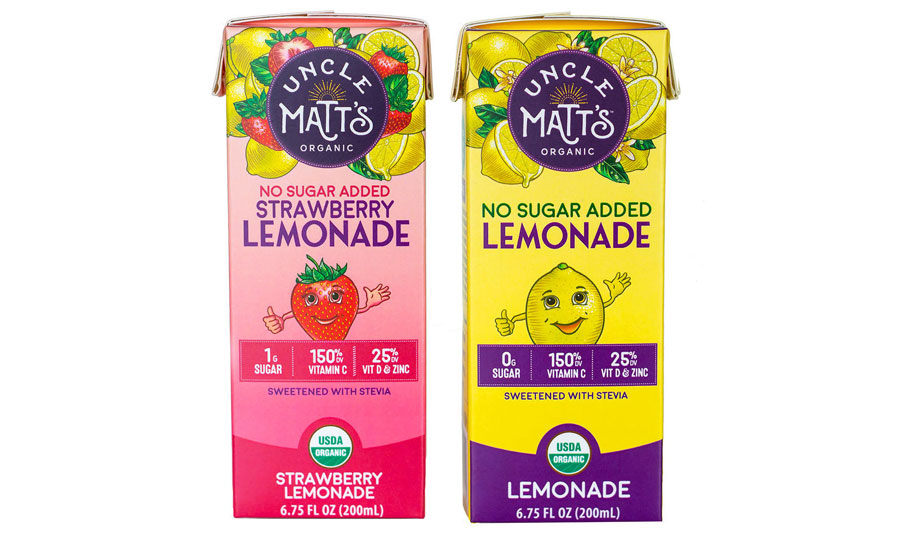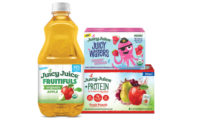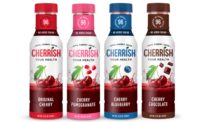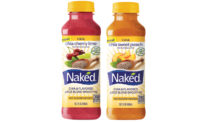Seven-year-old Tariq, better known as the “Corn Kid,” became an instant meme after a video of him professing his love for corn during a New York food festival went viral. The Gregory Brothers, a band that specializes in comedy music, remixed the interview and turned it into a song, which gained popularity on TikTok and YouTube. Tariq says, “It’s corn / A big lump with knobs / It has the juice (it has the juice) / I can’t imagine a more beautiful thing.”
Although corn juice isn’t a chart-topping, best-selling variety in the juice category — at least, not according to data from Chicago-based Information Resources Inc. (IRI) — bottled juices like apple juice and lemonade have seen dollar increases of 9.8% and 11.6%, respectively, in the 52 weeks ending Oct. 2.
According to IRI, the five top-selling bottled juice within that time frame were fruit drinks, cranberry cocktail juice, apple juice, lemonade and tomato/vegetable juice.
In that same time period, the five top-selling refrigerated juices/drinks were orange juice, fruit drinks, lemonade, juice and drink smoothies, and blended fruit juice. The five had sales performances, respectively, of 1.1%, 0.6%, 11.6%, -4.5% and 15.2%, according to IRI data.
The overall bottled juice category, with sales at $8.4 billion, was up 6.7%, in the 52 weeks ending Oct. 2, IRI data shows. Meanwhile, refrigerated juices/drinks, posted sales of $7.8 billion, a 2.9% increase for the same time-period. The aseptic juice category had dollar sales of $1.8 billion, up 15.1%. Sales of frozen juices were $290.6 million — an increase of just 0.4% for the same time last year.

Image courtesy of Uncle Matt’s
Data from Chicago-based research firm Mintel estimates that the 2022 sales in the United States of 100% juice drinks will reach $9.39 billion in 2022. The estimation for juice drinks is $12.1 billion, and ready-to-drink (RTD) smoothies is $1.09 billion.
“Total retail sales of juice and juice drinks increased an estimated 17.5% from 2017 to 2022, with sales reaching $22.5 billion,” says Caleb Bryant, associate director of food and drink at Mintel.
He adds that 58% of consumers note that high sugar content outweighs the benefits of juice and juice drinks.
Gary Hemphill, managing director of research at New York-based Beverage Marketing Corporation (BMC), agrees.
“Sugar content is the juice category’s greatest challenge,” Hemphill says. “While the overall category has a healthy halo because it comes from nature, sugar content is high in most products. This has negatively impacted consumption in recent years.”
Beverage-makers recognize this challenge and are tackling this through vanguard sweetener solutions. For example, Clermont, Fla.-based Uncle Matt's Organic announced the launch of two new offerings for kids: No Sugar Added Lemonade Juice Boxes and No Sugar Added Strawberry Lemonade Juice Boxes. The shelf-stable line contains zero added sugars, sweetened with stevia and boosted with 150% daily value for vitamin C, plus 25% for vitamin D and zinc for immune support, the company says.
| DOLLAR SALES | % CHANGE VS. PRIOR YEAR | MARKET SHARE | % CHANGE VS. PRIOR YEAR | |
| Orange Juice | $3,325,179,325 | 1.1 | 42.6 | -0.8 |
| Fruit Drink | $1,303,521,442 | 0.6 | 16.7 | -0.4 |
| Lemonade | $1,179,488,656 | 11.6 | 15.1 | 1.2 |
| Juice and Drink Smoothies | $908,353,339 | -4.5 | 11.6 | -0.9 |
| Blended Fruit Juice | $334,848,968 | 15.2 | 4.3 | 0.5 |
| Category total* | $7,811,175,336 | 2.9 | 100.0 | — |
Source: Information Resources Inc. (IRI), Chicago. Total U.S. supermarkets, drug stores, mass merchandisers, gas and convenience stores, military commissaries, and select club and dollar retail chains for the 52 weeks ending October 2.
“So many offerings for kids are still loaded with sugar as well as artificial colors, flavors and ingredients,” said Susan McLean, vice president of marketing and innovation at Uncle Matt's Organic, in a statement at the time of the launch. “We are proud to launch an organic beverage option that was carefully crafted with vitamins and antioxidants for added functional and wellness benefits.”
Uncle Matt’s Organic No Sugar Added Lemonade Juice Boxes and No Sugar Added Strawberry Lemonade Juice Boxes contain organic Reb A stevia, which delivers the desired, sugar-like sweetness that consumers want, with zero calories, and without the health concerns associated with artificial sweeteners, the company says.
Another example of brands addressing sugar content is Capri Sun, a brand of Kraft Heinz Co., Chicago. Earlier this year, the company announced the roll-out of its original juice drink pouches with an average of 40% less sugar than the current product. Each single serving now will have on average 8 grams of total sugars and 5 gram of added sugars. To achieve this reduction, the formulators utilized monk fruit concentrate, a natural sweetener that allows Capri Sun to reduce the sugar content, while maintaining its iconic taste, the company says.
“Sugar, especially in the beverage category, is a major pain point for parents,” said Erica Watkins, associate brand director for Capri Sun, in a statement at the time of the launch. “As a category leader and kids’ No. 1 favorite juice drink, it was critical that the renovation meet our brand’s size and scale without compromising either our iconic taste or our commitment to using all natural ingredients.”
Beyond sugar-reduced juice and juice drinks hybrid beverages have recently become more popular, with some products in the fruit beverage category, BMC’s Hemphill notes.
Nevertheless, despite their innovation, hybrid juice products “haven’t significantly impacted performance of the category overall,” he says.
The best performance comes from super-premium juices, Hemphill says.
“Juice is a great category for fortification and we’ve seen many examples of this in recent years,” he explains. “Calcium, vitamin D and C, and even zinc have been popular with juice brands.”
In terms of potential for cold-pressed and high-pressure processed (HPP) juices, Mintel’s Bryant says that only 6% of juice products launched in the United States this year were considered either cold-pressed or HPP, compared with 18% of juices in 2018.
However, according to data from Mintel, the share of launches of juices in 2022 that are vitamin/mineral fortified reached 30.4%, up from 16.9% in 2018. This year, the share of launches with antioxidants hit 13.8%, compared with 10.6% in 2018. Juices with added calcium also were also up in launches, at 7.8% in 2022 and only 2.6% in 2018.
As consumers demand more from their beverages, the juice industry must continue to meet their needs for functionality and healthfulness.




